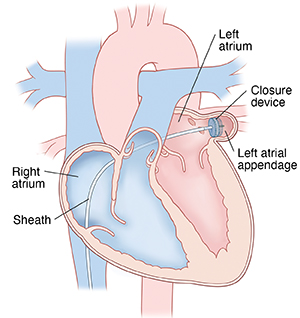Left atrial appendage closure (LAAC) is a heart procedure. It seals off the left atrial appendage (LAA) of the heart. The LAA is an outpouching of the left atrium, one of the top chambers of the heart. In people who have atrial fibrillation (a type of irregular heartbeat), blood clots tend to form in the LAA. A clot can then travel from the LAA to the brain. This causes a stroke.
LAAC may be done with a special implant. This implant is made of a metal alloy. It's put into the LAA. Over time, tissue grows over the implant. It seals off the LAA. By doing so, the device stops blood clots from leaving the LAA and moving to the brain. It can lower the risk for stroke if you have atrial fibrillation (AFib) not caused by mitral valve disease,
Why LAAC is done
Many people with AFib take blood thinners (anticoagulants) to prevent blood clots from forming. But some people may not be able to take these medicines. They may have a higher risk of bleeding when on them. Or they may not be able to deal with the side effects of the medicine. In these cases, LAAC with the implant device may be done. It can lower a person’s risk for stroke without taking blood thinners.
How LAAC is done
Before you have LAAC with the implant device, your health care provider may tell you to stop taking certain medicines. Tell your provider about all the medicines and herbal supplements you take. Your provider may also tell you to not eat or drink for some time beforehand. Make sure your provider knows about any allergies or other health problems you may have.
LAAC is usually done in a catheterization lab in a hospital. It typically takes about
-
You will lie down on your back on a table.
-
You will be given medicine through an IV (intravenous) line to help you relax and to block pain during the procedure. You may be given general anesthesia, so you sleep during the procedure. A heart ultrasound probe is often placed in the esophagus so the heart can be seen in real time.
-
The provider will place an access sheath in the leg vein at the groin area so that the closure device can be delivered to the heart.
-
The provider will put a longer sheath into the right atrium of the heart. The provider uses a small needle or wire to puncture the thin membrane between the right and left atrium. This is called a transeptal puncture. This lets the provider put the closure device into the LAA.
-
Once at the LAA, the delivery sheath will be placed into the LAA. Contrast is often used to take pictures of the LAA. After, the provider takes measurements to decide on the size of the closure device. They put the closure device into the LAA.
-
The provider will take several pictures with ultrasound and X-ray to make sure the device is well-seated and the LAA is closed. If the device isn't in the best place, the provider will move it until it is.
-
Once the device is in position and the LAA is closed, the provider will release the device and remove the delivery sheath from your body.
-
The provider will often close the groin access site with internal stitches and manual pressure.
What happens after LAAC
You will be taken to a recovery room. You will be watched to make sure the procedure went well. You may spend the night in the hospital. Or you may go home the same day.
When you return home, follow all directions from your provider. They may advise you to limit your activities for some time. You will have to take a blood thinner for about
Keep all follow-up visits with your provider. You will need an imaging test at some point to check that the LAA is closed off. Your provider may put you on a different blood thinner for about
Risks of LAAC
Like any surgical procedure, LAAC with the implant device has risks. Talk with your provider about them. They may include:
-
Allergic reaction to the anesthesia, the special dye, or the device.
-
Bleeding from the groin.
-
Bleeding from the heart.
-
Blood clots.
-
Failure or dislocation of the device.
-
Heart or blood vessel damage.
-
Infection.
-
Stroke.
-
Kidney damage.
-
Need for heart surgery.



